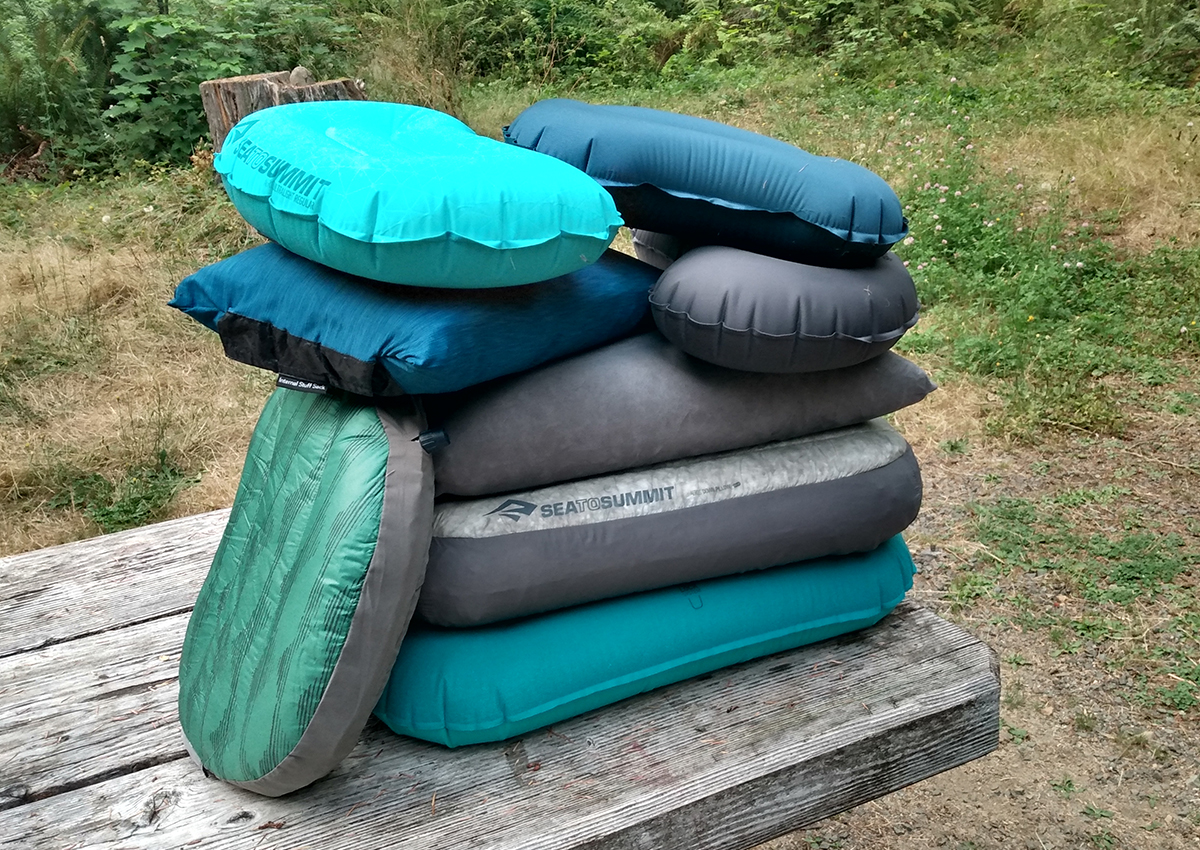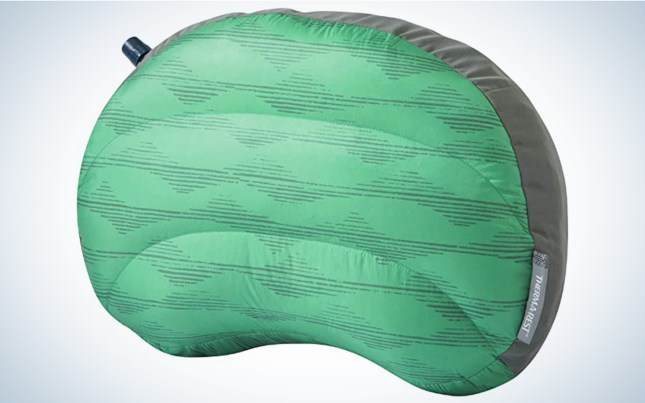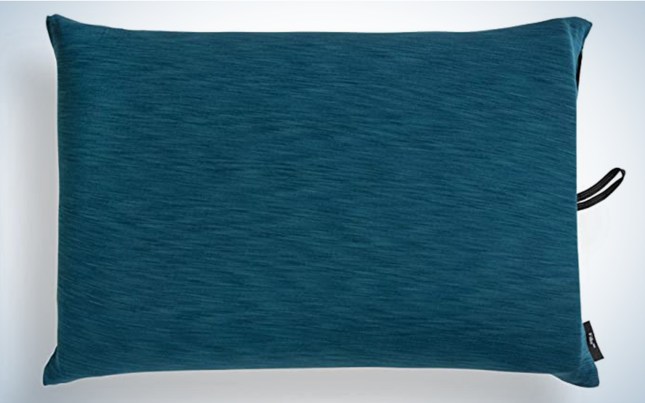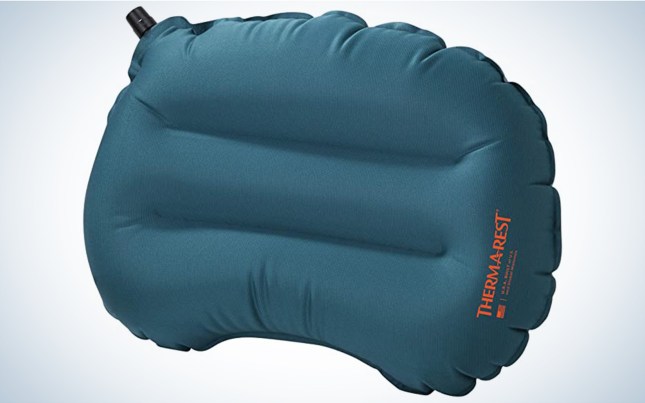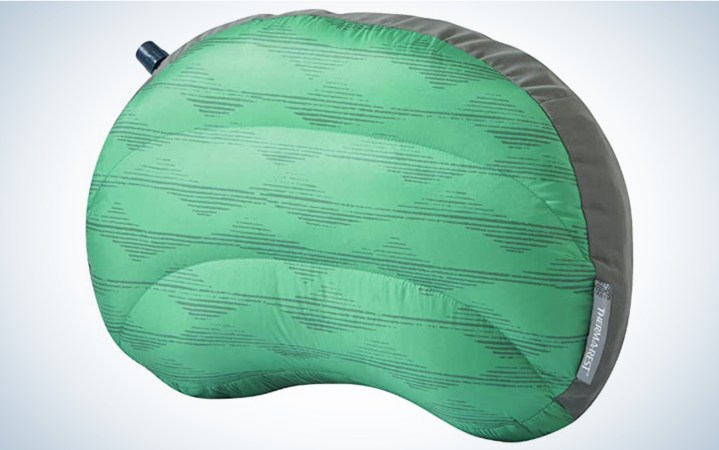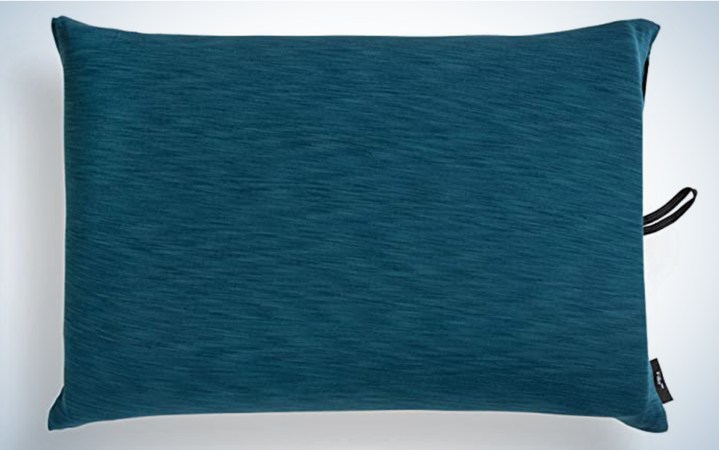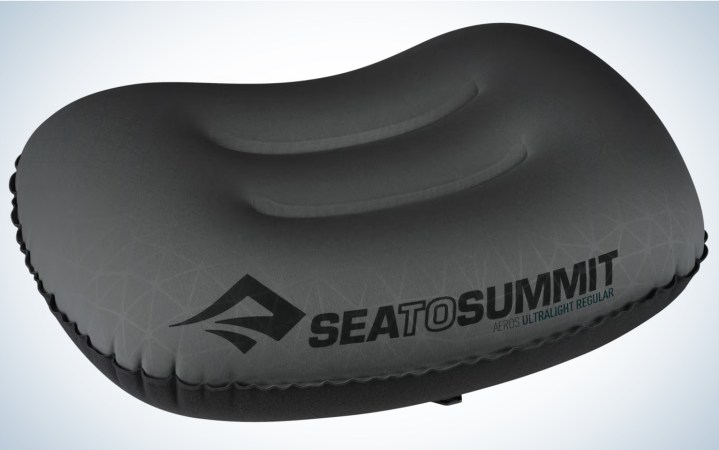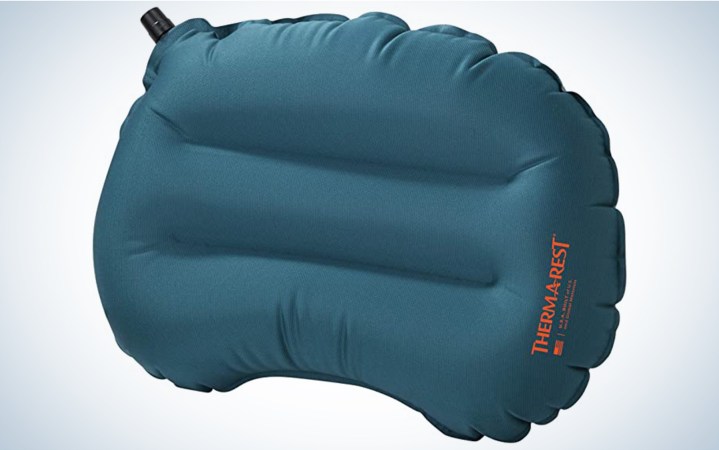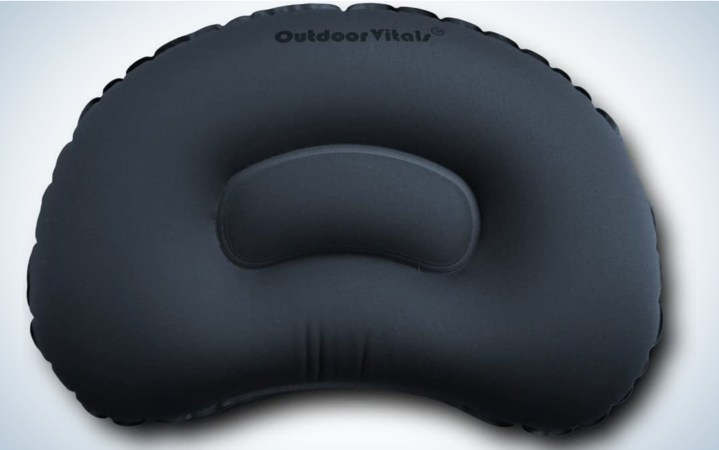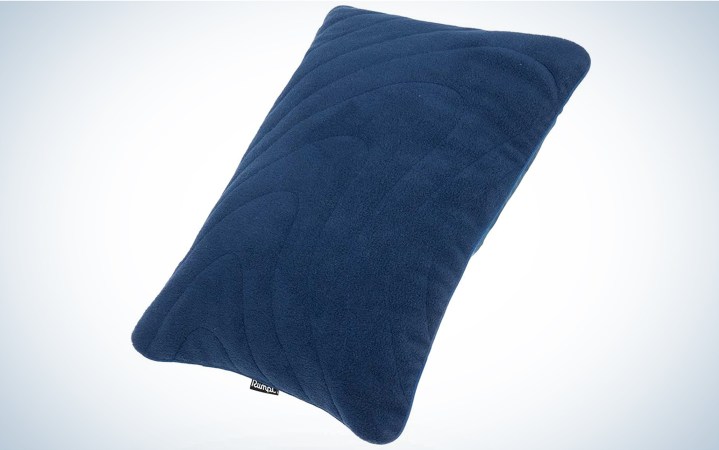We may earn revenue from the products available on this page and participate in affiliate programs. Learn More ›
If you peek into the pack of a seasoned long-distance hiker, there is one item that might surprise you: a backpacking pillow. Why, if you’re aiming for a sub-10-pound base weight, would they carry a luxury item like a pillow? I spent hundreds of nights sleeping outdoors with my puffer jacket balled up underneath my head before I started consistently sleeping through the night with a backpacking pillow. After testing out a number of the top options available, here are my picks for the best backpacking pillows:
- Best Overall: Therm-a-Rest Air Head Down Pillow
- Best Memory Foam: NEMO Fillo Backpacking & Camping Pillow
- Best Oversize: Sea to Summit Aeros Down Pillow
- Best Lightweight: Therm-a-Rest Air Head Lite Pillow
- Best Budget: Outdoor Vitals Ultralight Stretch Pillow
- Best Pillowcase: Rumpl Stuffable Pillowcase
| Pillow | Price | Weight | Width | Height | Fill |
| Therm-a-Rest Air Head Down | $60 | 4.9 ounces | 15.5 inches | 4 inches | Air, Down |
| NEMO Fillo | $40 | 9.2 ounces | 17 inches | 4 inches | Air, Memory Foam |
| Sea to Summit Aeros Down | $60 | 6.7 ounces | 23 inches | 4.7 inches | Air, Down |
| Therm-a-Rest Air Head Lite | $35 | 2 ounces | 15.5 inches | 4 inches | Air |
| Outdoor Vitals Ultralight Stretch | $25 | 2.6 ounces | 16 inches | 4 inches | Air |
| Rumpl Stuffable Pillowcase | $35 | 3.2 ounces | 16 inches | – | Extra clothing |
Best Overall: Therm-a-Rest Air Head Down Pillow
Why It Made the Cut
The Air Head Down Pillow has the best balance of comfort, warmth, and weight out of everything I tried.
Key Features
- Weight: 4.9 ounces
- Size: 15.5 inches x 11 inches
- Packed size: 5 inches x 4 inches
- Height: 4 inches
Pros
- Lightweight
- Retains some warmth overnight
- Mid-height will work with most people
Cons
- Narrow
- Less comfortable fabric than other deluxe pillows
- Expensive
Product Description
One of the biggest complaints people have about the air-only backpacking pillows is that they can be very cold. After a midnight bathroom break, it can be disconcerting to climb into one of the best sleeping bags and feel the cold polyester shell of an ultralightweight backpacking pillow.
The Thermarest Air Head Down Pillow uses a smidge of 650-fill power duck down, concentrated on one side of the pillow, to fix this problem. Down, the feathers found closest to the skin of ducks and geese retain warm air in small pockets created by the many barbules along the short shaft of the feather. In addition to adding warmth, they also add a bit of cushion. Despite the down, the size and shape of this pillow is similar to other ultralight designs, saving on weight. My only complaint is that the fabric on the side with the down wasn’t as smooth or comfortable as that used on other high-end backpacking pillows.
Best Memory Foam: NEMO Fillo Backpacking & Camping Pillow
Why It Made the Cut
If you prefer a stiffer, taller pillow that still cushions and conforms to the shape of your head, then the NEMO Fillo is the right choice for you.
Key Features
- Weight: 9.2 ounces
- Size: 17 inches x 11 inches
- Packed size: 6 inches x 4 inches
- Height: 4 inches
Pros
- Integrated stuff sack is easier to find in the morning
- Comfortable fabric on the pillow side
Cons
- Stiffer than classic memory foam pillows
- Valve is slightly more complicated to use
Product Description
Of all the pillows I tested, this is the one I have the most mixed feelings on. Its comparatively bulky packed size and significant weight addition raised my eyebrows, but when I put my head down, it was far and away the closest to the memory foam pillow I used at home. The knit fabric against my face was also comfortable for my skin, unlike some of the clammy polyesters and nylons used by the ultralight set. Not bad for just over half a pound.
The problem was when I woke up in the middle of the night with a stiff neck—I deflated the pillow some to try to create some “give,” to minimal effect. When I gave the NEMO Fillo to fellow campers to try, reviews were mixed—some found it incredibly comfortable throughout the night; others had the same experience that I did. I recommend having another individual check your neck alignment when lying down to ensure it isn’t at an angle before committing to a purchase.
Best Oversize: Sea to Summit Aeros Down Pillow
Why It Made the Cut
The Aeros Down is nearly as big as a standard bed pillow for only a couple of ounces more than my best overall pick.
Key Features
- Weight: 6.7 ounces
- Size: 23 inches x 15 inches
- Packed size: 6 inches x 3.5 inches
- Height: 4.7 inches
Pros
- Closest to a standard bed pillow of anything in my test
- Down adds both cushion and warmth
Cons
- Expensive
- May be too tall for some individuals
Product Description
Like my best overall pick, the Sea to Summit Aeros Down Pillow uses a layer of down to add both warmth and a bit of cushion. Unlike my best overall pick, the Sea to Summit Aeros Down Pillow is huge—easily one of the widest in my test. If you are the kind of person who tosses and turns at night, waking up to find your pillow anywhere other than under your head, this could be the solution you have been looking for. That goes double if you tend to stack two pillows on top of each other at home, as the 4.7-inch height of this pillow is fairly significant.
Best Lightweight: Therm-a-Rest Air Head Lite Pillow
Why It Made the Cut
This 2-ounce pillow packs up small and uses a knit polyester that is comfortable to the touch.
Key Features
- Weight: 2 ounces
- Size: 15.5 inches x 11 inches
- Packed size: 4 inches x 3 inches
- Height: 4 inches
Pros
- Lightweight
- Less expensive than more high-end options
- Low profile
Cons
- Not as comfortable as pillows that use down or memory foam
Product Description
This is the classic backpacking pillow—lightweight, low profile, and filled with nothing but air. It’s far from the most comfortable pillow I tested, but it would be my first choice for a longer backpacking trip, where I expect to spend most of the day on my feet, and I’m so exhausted that I’m asleep by 9. On those days, I’m a lot less likely to appreciate the creature comforts of a down or memory foam pillow anyway.
Something I liked about the Air Head Lite is that it is one of the slimmer models (4 inches) I looked at, and it had a flat profile. Other pillows I tried, such as the EXPED Ultra Pillow, are thicker at the base of the pillow—to support your neck—but this can be distracting, and I find my head tends to slide off or rest at an uncomfortable angle (more often than not I just swap the side I’m sleeping on and use only half the pillow). The streamlined profile of the Therm-a-Rest Air Head Lite Pillow means that it will be comfortable for the widest range of people.
Best Budget: Outdoor Vitals Ultralight Stretch Pillow
Why It Made the Cut
This budget backpacking pillow is only a hair heavier than other top lightweight pillows, while coming in at a significantly reduced price.
Key Features
- Weight: 3.1 ounces (as measured)
- Size: 16 inches x 10 inches
- Packed size: 4.5 inches x 3.5 inches
- Height: 4 inches
Pros
- Inexpensive
- Packs down small
Cons
- Neck support may be uncomfortable for some individuals
- Not quite as lightweight as similar models I looked at
Product Description
This pillow, while not as comfortable as the other picks on this list, gets the job at a significantly reduced price. If you’re curious to see how a backpacking pillow can improve your sleep but wary about the price point of the higher-end models, then the Outdoor Vitals Ultralight Stretch Pillow is a good place to start.
Unlike the other backpacking pillows I looked at, this one was slightly higher at the bottom of the pillow than it was at the top, with a slight depression in the middle. Some people enjoy the neck support this type of design provides, but it can be uncomfortable for others.
Best Pillowcase: Rumpl Stuffable Pillowcase
Why It Made the Cut
The soft fleece side of this pillowcase felt great to the skin on cold nights. The adjustable height is best suited for stomach sleepers.
Key Features
- Weight: 3.2 ounces
- Size: 16 inches x 11 inches
- Packed size: 6.5 inches x 3.5 inches
- Height: Not applicable
Pros
- Height of the pillow can be adjusted
- Small packed size
Cons
- On cold nights, you’ll have to decide between your puffer jacket and having a pillow
Product Description
I’ll admit that I didn’t get to test the Rumpl Stuffable Pillowcase as much as I wanted because the second my three-year-old tried it, she claimed full ownership. But I see her point: the fleece-lined side was significantly nicer to the touch than the cold nylon or polyester of the other models I tested (even if these did warm up quick enough), and she could choose the exact height that the pillow would be when she laid down on one of the best backpacking sleeping pads. In her case, the puffer coat was much too tall, but a single long sleeve shirt gave her just the height she needed.
Things to Consider Before Buying Backpacking Pillows
Weight
Backpacking pillows can vary in weight considerably, from two ounces to over half a pound. Your goal when choosing a backpacking pillow is to pick the option that optimizes your sleep without overly weighing down your backpack.
Packed Size
While there are a number of high-quality foam pillows built for the outdoors, few pack down as small as the NEMO Fillo, making them a no-go for backpackers.
Insulation
The smallest backpacking pillows are simple inflatables. While this helps to keep the cost, packed size, and weight down, these pillows do not retain much (if any) heat. While this can be offset by a sleeping pad with a higher R rating, light sleepers may find that shifting to a cold part of the pillow causes them to wake up more often than they would like.
Height
The reason that a pillow can help to improve your sleep is that it helps to keep your neck at an even angle, something known as neutral alignment. The right height varies by person, but you can get a sense of your natural preference by looking at the height and number of pillows you currently use at home.
Methodology
I tested backpacking pillows on a series of summer overnights and shared them with the people I was camping and backpacking with in addition to using them myself. I looked at how comfortable the pillow was, whether it was clammy or soft to the touch when I first laid my head on it, and if I woke up in the middle of the night for any reason (neck pain, pillow shifted, etc.) While everyone agreed that a pillow—any pillow—was better than balling up one of the best puffer coats, not everyone agreed on which pillow was the most comfortable—or even comfortable at all. If you have the option to test out a number of pillows before making a purchase (such as at an outdoor retailer), that will help you make the right choice for yourself.
In addition to field testing the backpacking pillows, I also considered their price, packed size, and weight—all important considerations for backpackers.
FAQs
Yes, they are worth it.
If you’re balling up your puffer coat to serve as a “pillow” in the backcountry, that’s the first sign that you need to get a real backpacking pillow. The next time you’re out, count the number of times you wake up in the middle of the night and adjust the jacket so that it’s still comfortable under your head. If the answer is more than “I never woke up” then you should strongly consider getting a backpacking pillow.
If you consistently sleep on your stomach, it’s possible that you won’t benefit from a backpacking pillow. One way to determine if this is the case for you is to swap out your regular pillow at home for something low profile or ditch it all together—if you sleep soundly through the night without it, then you can probably skip the pillow in the future.
Final Thoughts
After looking at a number of backpacking pillows, the Therm-a-Rest Air Head Down Pillow is the best balance of comfort and weight, while the two-ounce Air Head Lite is ideal for gram counters. Those looking for even more comfort appreciate the wide profile of the Sea to Summit Aeros Down Pillow or the memory-foam NEMO Fillo.
